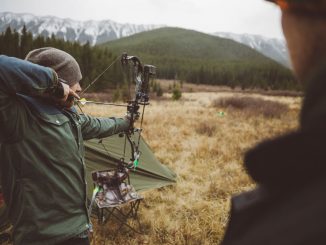
Providing you with the information and knowledge you’ll need to survive any emergency situation is our goal. Because this can be a complicated endeavor, we’ve developed this “prepper’s checklist” to help simplify and organize your efforts and gear.
Whether you’re concerned about a short-term rural survival scenario, civil unrest in an urban area or a massive natural disaster, American Survival Guide is dedicated to making sure you know what it takes to develop the skills and collect the right gear to protect yourself and the rest of your survival group.
This comprehensive checklist is invaluable for ensuring you have what you need to survive almost any adverse situation. It is organized according to our “Six Pillars of Survival”—Food, Water, Shelter, Security, Communications and Health—so you can instantly assess and track your level of preparedness in each area. We encourage you to customize it so it will meet your specific requirements.
We suggest you carefully cut these two pages from this issue and make copies to be kept in your storage area as an inventory sheet and also with your important documents. It can even be used as a shopping list for items you haven’t acquired yet.

1. FOOD PILLAR
ASG recommends keeping a 30-day food supply on hand for each person. Remember that, on average, men need about 2,500 calories a day and women need around 2,000. Depending on your condition, level of stress and physical exertion, you might need more.
1.1. FOODSTUFFS
- Cooking oils (coconut, vegetable, olive, etc.)
- Cooking powders (flour, baking powder/soda, etc.)
- Dairy products, dry
- Eggs, dry
- Freeze-dried entrees and meals
- Fruit (dried, canned, preserved)
- Grains and cereals
- MREs and other ready-to-eat packaged foods
- Pasta
- Protein, animal (fish, meat, poultry)
- Protein, plant (beans, lentils, nuts, powdered mixes)
- Rice
- Salt, iodized
- Seeds for both consumption and planting
- Soups and stews
- Sweeteners (agave, honey, sugar, etc.)
- Vegetables (dried, canned, preserved)
1.2. FOOD PROCUREMENT NEEDS
1.2.1. HUNTING AND TRAPPING
- .22 air pellet gun and pellets and gas cartridges
- .22 rifle and ammo
- Compound bow/crossbow and arrows
- Maintenance materials for items in this group
- Rifle and ammo
- Shotgun and ammo
- Traps and snares
1.2.2. FISHING
- Compact fishing kit
- Full-sized fishing rod and tackle
2. WATER PILLAR
You should have enough potable water to support each person with 2 gallons per day for 30 days for hydration, food preparation and hygiene. Store water away from light, chemicals and pesticides, and don’t stack plastic containers on concrete surfaces. Always use opaque, FDA-approved, food-grade containers to store your water. ASG recommends you cycle your water supply every six months—unless you treat it with a water preservative.
2.1. WATER STORAGE OPTIONS
- Individual bottles or cans
- Portable water containers (1-, 5- or 7-gallon sizes)
- Static water containers (30- and 50-gallon drums, larger tanks or blivets, cistern)
- Water resupply plan
2.2. PRESERVATION AND TREATMENT
- Chemical disinfectant supplies
- Heat source and fuel for boiling water
- Ultraviolet water sterilizer
- Water filter/purifier (one filter/purifier per person)
- Water flavor enhancer to improve the taste of treated water
3. SHELTER PILLAR
In an emergency, you are usually better off hunkering down in your home. But a time might come when you need to seek shelter elsewhere. In addition to knowing where local emergency shelters are, you need to have a bug-out plan for a safe location where you can take shelter.
3.1. HUNKERING DOWN AT HOME
- Fire extinguishers
- Generator, fuel and maintenance tools and materials
- Power inverter
- Smoke and carbon monoxide alarms and batteries
- Wood or manufactured fireplace logs and kindling
3.2. FABRICATED SHELTER
- Sleeping bags and ground mats, appropriately sized and insulated
- Tarps, real 550 cord and bungee cords
- Tent replacement and repair parts
- Tent(s) large enough for people, pets and weather-sensitive gear
3.3. LOCAL EMERGENCY SHELTER
- Know the location of the closest emergency shelter
3.4. CLOTHING AND EQUIPMENT
- Base layer and street clothing suited to your environment at any time of the year
- Hunting/camouflage clothing and accessories
- Insect and snake-protective clothing
- Weather-resistant clothing, outerwear, headwear and footwear
4. SECURITY PILLAR
The Security Pillar includes safety issues, along with self-defense, making it a very broad category. If you have additional security and safety preparations, you should add them to this list.
4.1. HOME SECURITY/EARLY-WARNING SYSTEM
- Home alarm
- Motion detectors
- Remote camera systems
4.2. LETHAL WEAPON SYSTEMS
- Handgun and spare mags or speed loaders, ammo and accessories
- Rifle and spare mags, ammo and accessories
- Shotgun ammo and accessories
4.3. LESS-LETHAL WEAPON SYSTEMS
- Less-lethal shotgun rounds
- Personal defense spray/tear gas dispenser and replacement cartridges
- Restraint systems
- Stun gun and batteries
- Taser and replacement cartridges, batteries and other accessories
5. COMMUNICATIONS PILLAR
- Amateur/HAM radio, CB radio scanner and accessories
- Cell phone and accessories
- Chargers and batteries
- Faraday cage or other protective containers
- FM/AM/SW/Weather radio and accessories
- Personal locator beacon/EPIRB
- Satellite phone and accessories
- Solar charging panel and accessories
- Television and power source
- Two-way radios and accessories
6. HEALTH PILLAR
- 90- to 180-day supply of all vital prescription medications
- Backboard or other litter
- Blankets/space blankets
- Emergency dental kit, one per person
- Epinephrine pen kit
- Home first aid kit
- Individual first aid kit, one per person
- Neck brace and splints
- Personal hygiene kit, one per person
- Slings and cravats
- Snake bite kit, one per person
- Special medical equipment: defibrillator, CPAP, oxygen machine and any accessories
- Suture kit
- Trauma kit, one per person
ADDITIONAL ITEMS
- Assorted hand tools, according to your needs
- Bug-out bag/three-day pack
- Bushcraft knife (we suggest carrying more than one knife)
- Candles
- Dependable transportation, fuel, and repair and maintenance supplies
- Flashlights and hands-free lights and batteries
- GPS, compass, maps, protractor and marking pens
- Optics for day, night and thermal, and batteries and accessories
- Pace-counter beads
- Road flares
- Wind/waterproof matches, fire starters and tinder
- Windproof lighter and fuel
EMERGENCY PLANS
- Bug-out plan and leave-behind note
- Group emergency preparedness plan
- Local Community Emergency Response Team (CERT) point of contact
- Local FEMA/Homeland Security point of contact
- Local hospital phone number
- Phone number and address of local National Guard Armory
- Police and fire phone numbers
Editor’s note: A version of this article first appeared in the Prepper Fall, 2018 print issue of American Survival Guide.






Be the first to comment